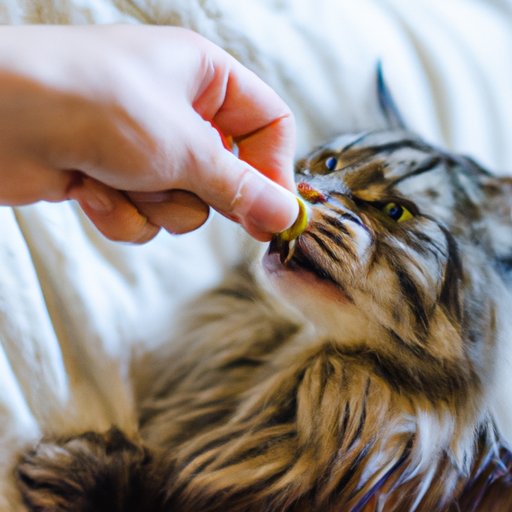
Introduction
If you’re a cat owner, you’ve probably experienced your cat biting at some point. While it may seem cute or playful, biting can actually be dangerous and harmful to both you and your cat. In this article, we’ll explore the reasoning behind a cat’s biting behaviour and provide some tips on how to train your cat to stop biting.
Understanding the Reasoning behind a Cat’s Biting Behaviour
Before you can start training your cat to stop biting, it’s important to understand why they do it in the first place. Cats can bite for a variety of reasons: playfulness, fear, anxiety, or aggression. Although biting can be a natural behaviour for cats, it’s important to identify the triggers that cause your cat to bite. Common triggers include being petted or handled in a way your cat dislikes, loud noises or sudden movements, and not having an appropriate outlet for their energy.
Training Your Cat with Positive Reinforcement
Positive reinforcement training is a great way to encourage good behaviour and discourage bad behaviour. This training relies on rewarding your cat with treats and praise for exhibiting the behaviour you want to encourage. When it comes to biting behaviour, you can use positive reinforcement by offering your cat a treat or toy for exhibiting calm behaviour instead of biting. If your cat does bite, it’s important not to physically punish them as this could encourage further aggression.
Providing Your Cat with Interactive Toys
Interactive toys are another great way to reduce biting behaviour by providing your cat with an outlet for their energy. Toys that you can play with your cat, like a laser pointer or feather wand, are great for encouraging playfulness and keeping cats engaged. Puzzle toys, such as a treat dispenser, can provide mental stimulation and keep your cat occupied. It’s important to find the right type of toy that your cat responds to and to regularly rotate their toys to keep them interested.
Consistently Using a Firm Tone of Voice and “No”
Verbal correction is an important part of training your cat to stop biting. Using a firm tone of voice and saying “no” when your cat exhibits unwanted behaviour can help them understand what behaviour is undesirable. However, it’s important to be consistent with verbal correction and to avoid physically punishing your cat. Punishment could lead to fear and mistrust, which could exacerbate biting behaviour.
Encouraging Calm Behaviours
Loud noises and sudden movements can trigger biting behaviour in cats. Encouraging a calm atmosphere around your cat, especially during playtime and when handling them, can help to decrease anxiety and reduce biting. It’s important to avoid startling your cat or engaging them in rough play, as this can encourage aggressive behaviour.
Appropriate Handling and Petting Techniques
Proper handling and petting is key to preventing biting behaviour in cats. It’s important to handle your cat gently and respect their personal space. You can start by letting your cat come to you and avoid approaching them too quickly or forcefully. Additionally, it’s important to identify where your cat doesn’t like to be touched, such as their stomach or tail, and to respect their boundaries. When petting your cat, use long strokes versus quick, rapid movements.
The Importance of Seeking Professional Help
If biting behaviour persists despite consistent training, it’s important to seek professional help. Animal behaviourists and vets can provide expert advice and guidance on how to modify your cat’s behaviour. They can even identify underlying medical issues or conditions that may be contributing to biting behaviour, such as dental pain or a thyroid issue.
Conclusion
Training your cat to stop biting can be a frustrating process, but it’s important to be persistent and consistent with your training techniques. Positive reinforcement, providing interactive toys, and creating a calm atmosphere can all help reduce biting behaviour in cats. Remember to be patient and seek professional help if needed. With the right techniques and approach, your cat can learn to stop biting and become a happier and healthier companion.





